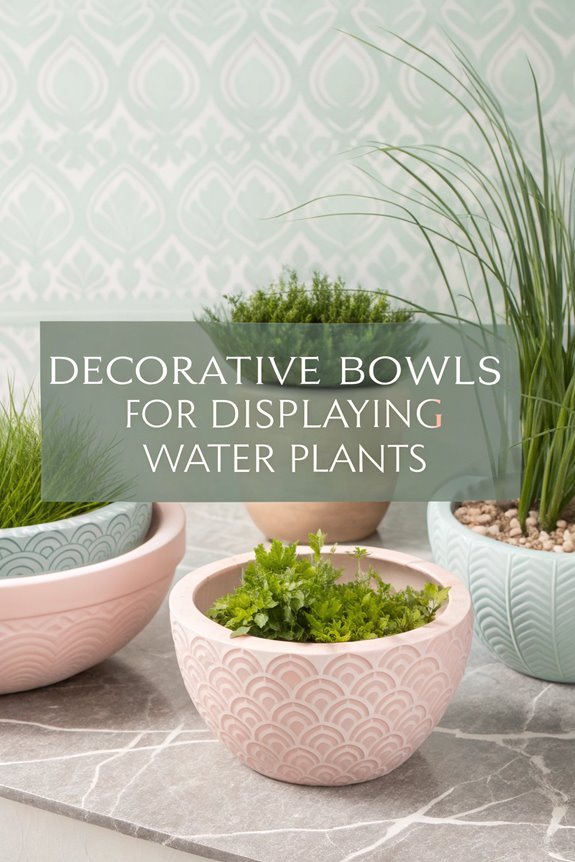22 Best Shade Plants for Front Yard Landscaping
Finding the ideal shade plants for your front yard can feel like uncovering a hidden treasure. From colorful flowers to rich foliage, many plants thrive in low light and can turn your outdoor space into a tranquil retreat.
If you’re eager to learn which plants will elevate your yard and impress the neighbors, let’s explore the 22 best shade-loving options available. Discover how these stunning selections can enhance your landscape!
Hostas

When you think of shade gardens, hostas are like the rock stars of the plant world—bold, beautiful, and ready to steal the show!
These leafy wonders come in various sizes, colors, and textures, so you can mix and match to create a stunning visual feast. Just imagine lush greens, vibrant blues, and even striking yellows dancing together in your garden!
Plus, they’re low-maintenance, thriving in those tricky shady spots where other plants throw in the towel.
With their heart-shaped leaves and elegant blooms, hostas add a touch of drama, making your landscape feel like a backstage pass to nature’s best show!
Astilbe
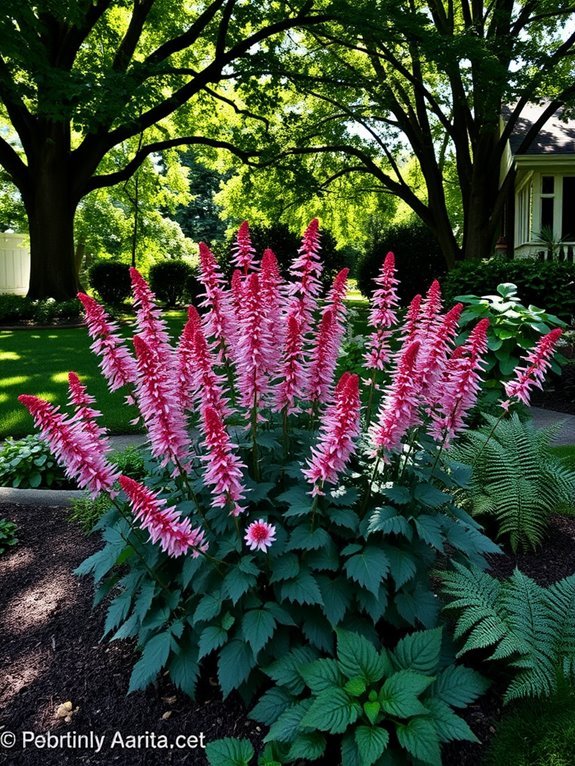
If you’re looking to add a splash of color and texture to your shady corners, astilbe is a fabulous choice!
These beauties boast feathery plumes in shades of pink, white, and red, giving your garden a whimsical touch. They thrive in moist, well-drained soil, so don’t forget to water them regularly—nobody likes a thirsty plant!
Plus, astilbe pairs wonderfully with hostas, creating a lush, layered look. As a bonus, these plants attract butterflies, making your garden a lively hotspot.
Ferns
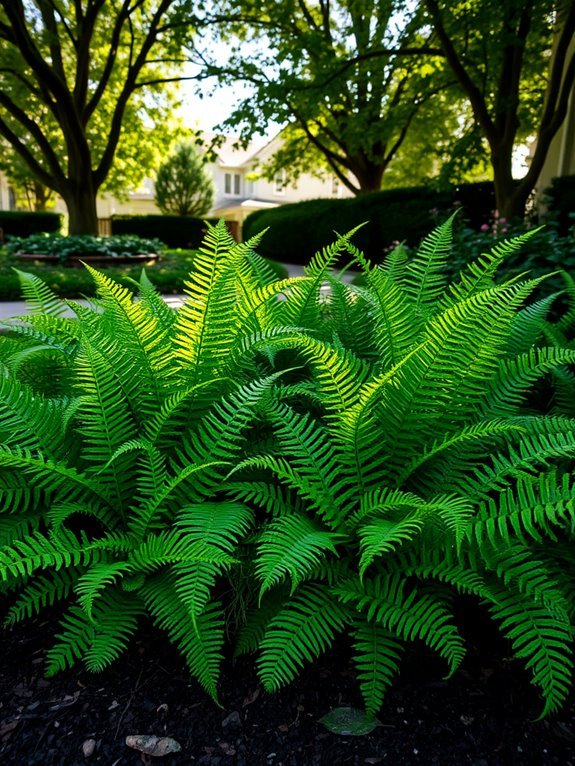
Ferns can bring a lush, tropical vibe to your shady spots, and they’ve got a charm all their own! With their feathery fronds and vibrant green hues, they create a soft, inviting feel in any garden.
You’ll love how easy they’re to care for—just keep ’em moist and they’ll thrive. Whether you opt for the classic Boston fern or a more exotic variety, these plants are sure to steal the show.
Plus, they’re great at softening hard edges in your landscape. So, go ahead, embrace the fern trend and let your shady areas flourish with style!
Bleeding Heart
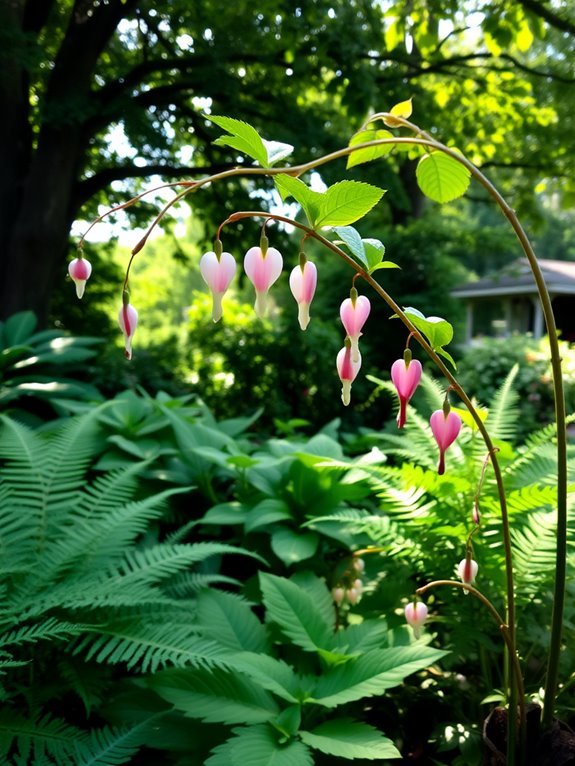
Add a splash of whimsy to your shady garden with the Bleeding Heart! This enchanting plant boasts heart-shaped blooms that dangle like little charms, making it a favorite for many gardeners.
You’ll love how the soft pink or white flowers bloom in spring, creating a stunning display that’ll have your neighbors asking for tips.
Bleeding Hearts thrive in moist, well-drained soil, so keep that watering can handy. Plus, they’re low-maintenance, which means more time to sip iced tea and admire your garden!
Plant them in clusters for a truly magical effect. Trust me, your garden will thank you!
Heuchera (Coral Bells)
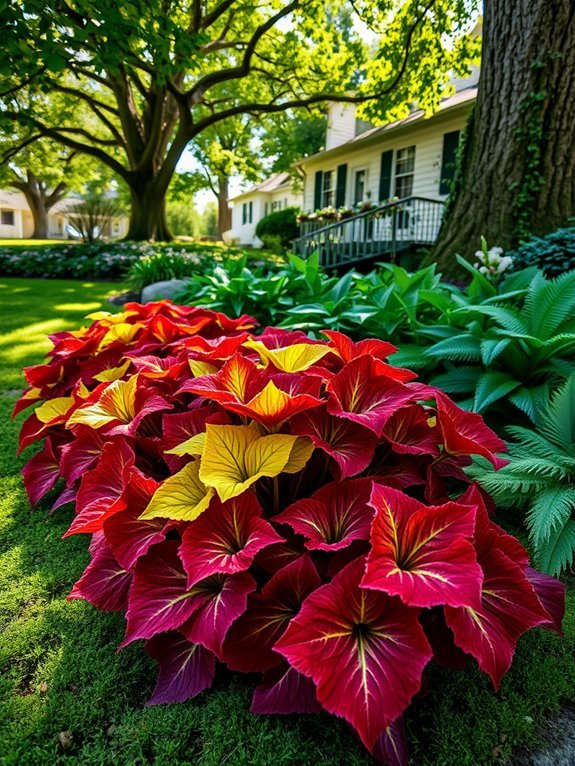
Heuchera, commonly known as Coral Bells, is a true showstopper in any shady garden!
These delightful plants come in a rainbow of colors, from vibrant purples to cheerful greens, making them a fantastic addition to your landscape.
They’re not just pretty faces; their unique leaves add texture and interest year-round.
Plus, Coral Bells produce charming flower spikes that attract butterflies, so you’ll have a lively garden party right outside your door!
Don’t worry about fuss; they’re low-maintenance and thrive in partial shade.
Plant them in clusters for a stunning display, and watch your front yard transform into a colorful oasis!
Japanese Maple
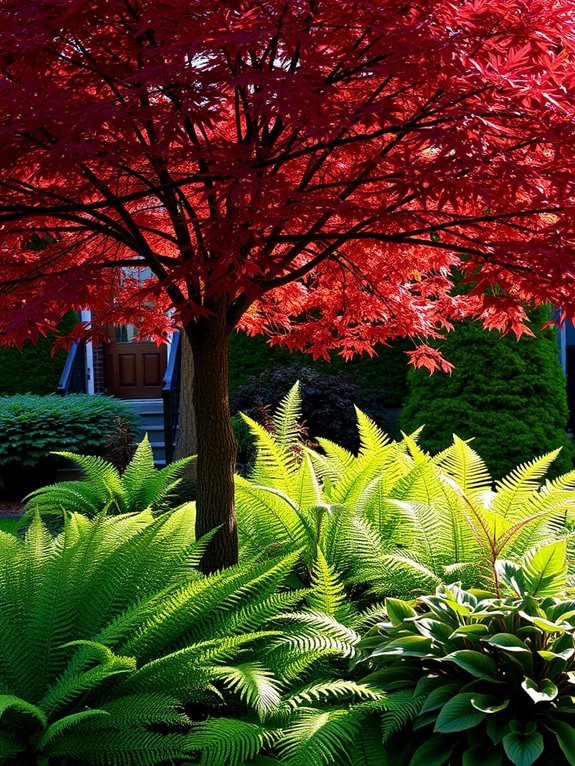
Picture a stunning centerpiece in your garden that’s as graceful as it’s vibrant—enter the Japanese Maple! This tree steals the show with its delicate leaves, showcasing hues ranging from deep red to soft green.
You’ll love how it transforms your front yard, adding elegance and charm. Plus, its size is perfect for smaller spaces, so you don’t need a sprawling yard to enjoy its beauty.
Just imagine sipping your morning coffee under its dappled shade, feeling like royalty! With a bit of care, this tree will thrive and delight you for years, making every glance outside feel like magic.
Brunnera (False Forget-Me-Not)

When you want a splash of color in those shady spots of your garden, Brunnera, or the False Forget-Me-Not, is a fantastic choice!
With its heart-shaped leaves and delicate, sky-blue flowers, it adds charm and whimsy to your landscape.
These beauties thrive in partial to full shade, making them perfect for those tricky areas where sunlight struggles to peek through.
Plus, they’re low-maintenance, so you can spend less time worrying and more time enjoying your garden.
Just imagine those tiny flowers dancing in the breeze—it’s like nature’s own confetti!
Don’t miss out on this delightful addition to your front yard!
Lungwort
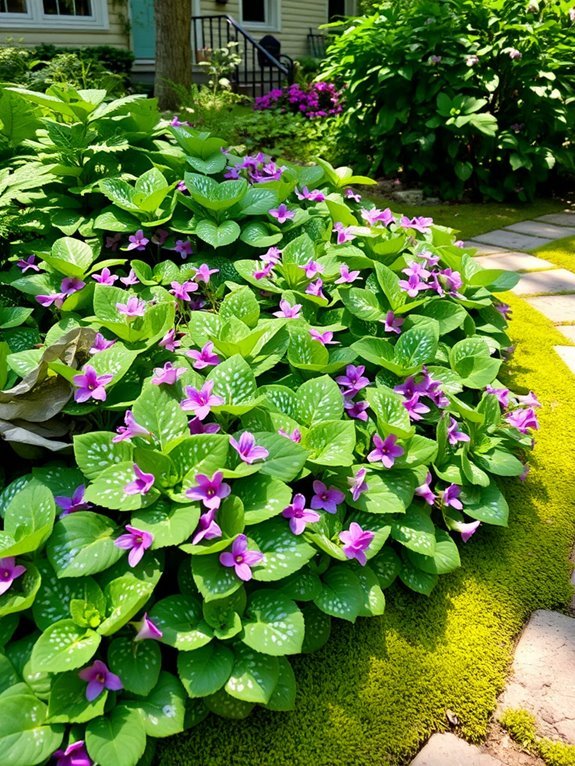
If you’re looking to complement the charming Brunnera in your shady garden, Lungwort is a fantastic choice!
This delightful plant boasts stunning spotted leaves that can add a splash of interest to any corner. Plus, it produces lovely, tubular flowers in shades of blue, pink, or white, which bees simply adore.
Lungwort thrives in moist, well-drained soil, making it easy to care for. Just imagine how happy your garden will look with these beauties!
And don’t worry, they’re not picky, so you can plant them and let them do their thing. Your shady spot will thank you!
Tiarella (Foam Flower)

Tiarella, commonly known as Foam Flower, is a delightful addition to any shady garden, bringing both charm and flair to your landscape!
With its frothy white blossoms and lush foliage, it’s sure to catch your eye. Here are some reasons to contemplate Tiarella:
- Thrives in partial to full shade
- Easy to grow and maintain
- Attracts pollinators like bees and butterflies
- Comes in various leaf shapes and colors
- Provides excellent ground cover
Imagine strolling through your garden, surrounded by these lovely blooms.
You’ll be amazed at how Foam Flower can transform your front yard into a serene oasis!
Solomon’s Seal
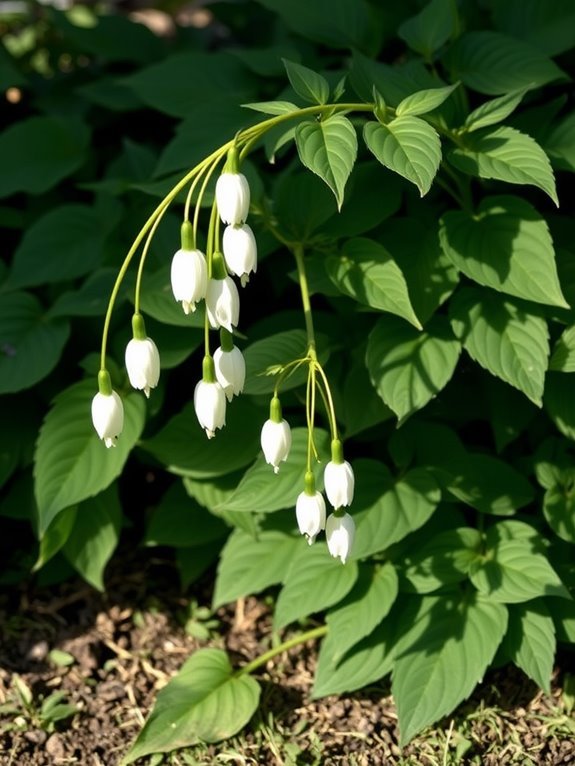
After enjoying the charming presence of Tiarella in your shady garden, it’s time to explore another spectacular plant: Solomon’s Seal.
This beauty features arching stems draped with elegant, tear-drop shaped leaves. You’ll love how it brings a graceful touch to your landscape.
In spring, watch for delicate, bell-shaped flowers that dangle like little ornaments. It’s like nature’s own jewelry!
Plus, Solomon’s Seal thrives in moist, well-drained soil, making it a low-maintenance gem. Just be sure to give it some space to spread out.
You’ll soon find it’s a delightful addition that’ll make your garden shine!
Hellebores

Hellebores, often called Lenten roses, are like the cheerful harbingers of spring that brighten up your shady garden.
These hardy perennials bloom when most plants are still sleeping, adding a splash of color when you need it most. You’ll love them for their unique charm!
- They thrive in partial to full shade.
- Their flowers come in various colors, from soft pastels to deep hues.
- They’re deer-resistant, so no worries about those pesky nibblers.
- They’re low-maintenance, perfect for busy gardeners.
- Hellebores can bloom for months, giving you long-lasting beauty.
Give your garden a delightful boost with these lovely plants!
Pulmonaria (Lungwort)
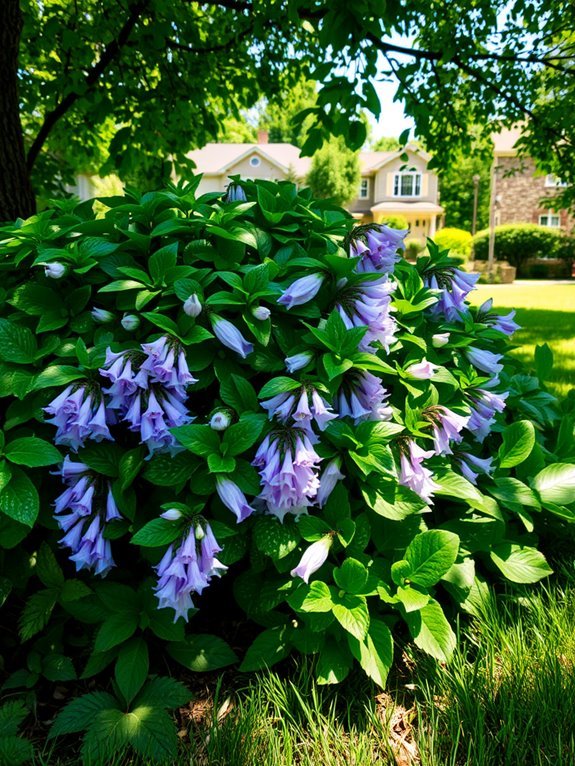
If you’re looking to add a splash of color and texture to those shady corners of your garden, Pulmonaria, commonly known as Lungwort, might just be your new best friend!
With its stunning spotted leaves and delicate blooms in shades of blue, pink, or white, it’s like nature’s own confetti. Lungwort thrives in moist, well-drained soil, making it perfect for those tricky spots.
Plus, it’s a magnet for pollinators, so you’ll have butterflies and bees dancing around your garden. Just remember, it loves a little shade, so give it a cozy spot, and watch it flourish!
What a delightful addition!
Periwinkle
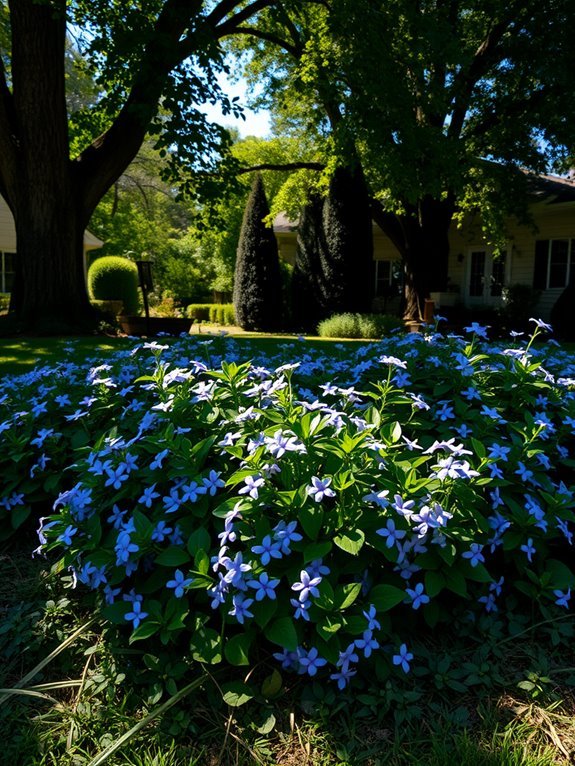
When you want to brighten up those shady spots in your garden, search no more than Periwinkle, also known as Vinca minor. This charming ground cover thrives in low light and adds a splash of color with its lovely blue or purple flowers.
Plus, it’s super easy to care for!
Here are some reasons to love Periwinkle:
- Tolerates drought and poor soil
- Spreads quickly, filling in bare spots
- Attracts pollinators like bees and butterflies
- Provides year-round greenery
- Lovely flowers that bloom in spring
Ajuga (Bugleweed)
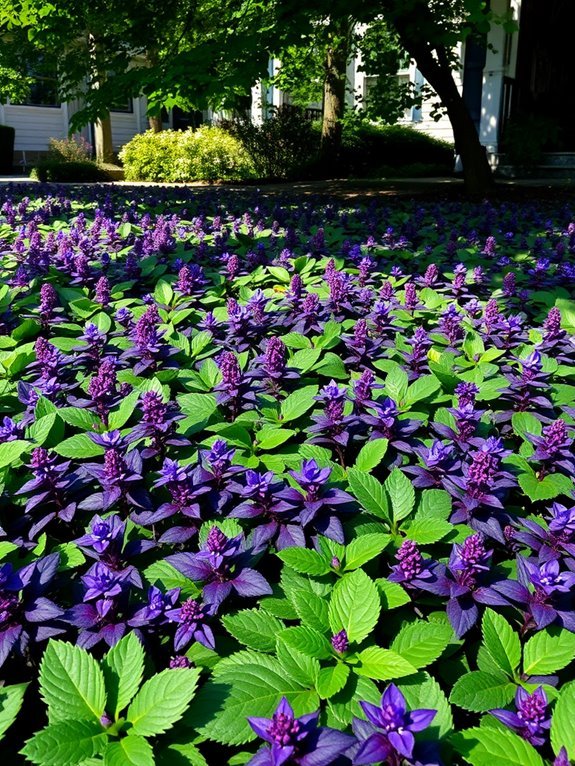
Ajuga, often affectionately called Bugleweed, is a fantastic choice for those tricky shade areas in your garden.
With its lush, low-growing foliage and stunning blue flowers, it’ll bring a pop of color to your shady spots. This plant spreads quickly, creating a beautiful ground cover that suppresses weeds—bonus!
Plus, it’s low maintenance, so you won’t need to babysit it constantly. Just plant it, and let it do its thing.
Ajuga thrives in various soil types, making it super adaptable.
Epimedium (Bishop’s Hat)
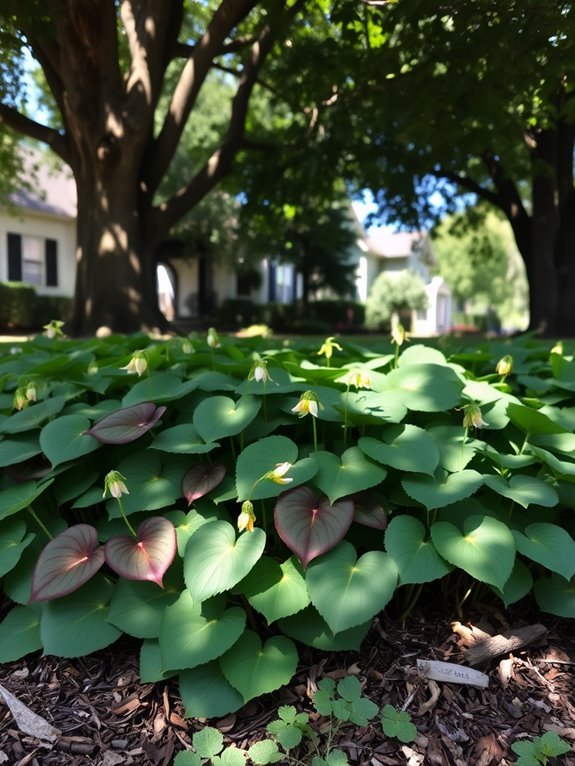
Now that you’ve discovered the wonders of Ajuga, let’s shine a spotlight on another shade-loving superstar: Epimedium, also known as Bishop’s Hat.
This charming plant thrives in the shadiest spots of your yard, boasting beautiful heart-shaped leaves and delicate flowers that dance in the breeze.
Here’s why you’ll love Epimedium:
- Tolerates dry shade like a champ
- Gorgeous, lush foliage year-round
- Easy to maintain with minimal fuss
- Attracts pollinators to your garden
- Provides a lovely ground cover
With its unique appeal, Epimedium is sure to make your front yard a standout in any neighborhood!
Variegated Liriope
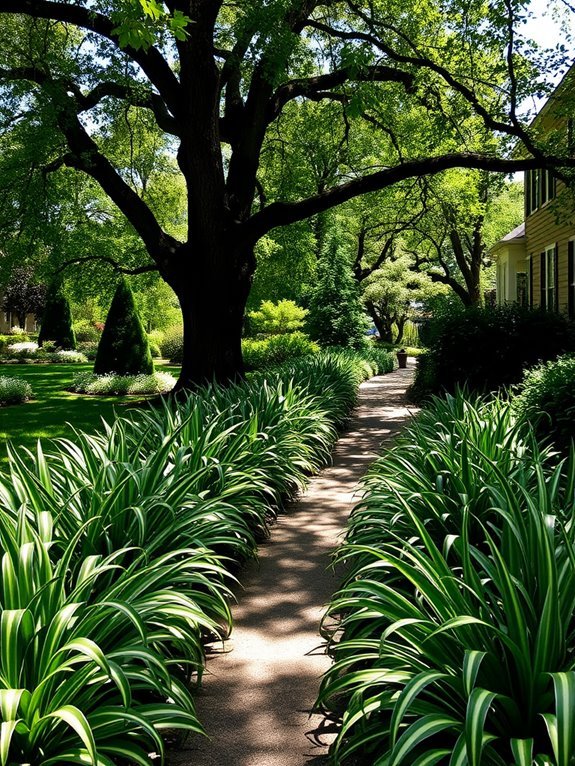
If you’re on the hunt for a reliable and stylish plant to brighten up those shady corners of your garden, search no more than Variegated Liriope!
This gem boasts striking green and white leaves that dance in the breeze, adding a pop of visual interest. Plus, it’s tough as nails—thriving in various conditions without demanding much attention.
You’ll love how it forms neat clumps, making it perfect for borders or mass plantings. And don’t forget the lovely purple flowers that emerge in late summer, attracting butterflies.
With Variegated Liriope, your shade garden will be the envy of the neighborhood!
Japanese Forest Grass
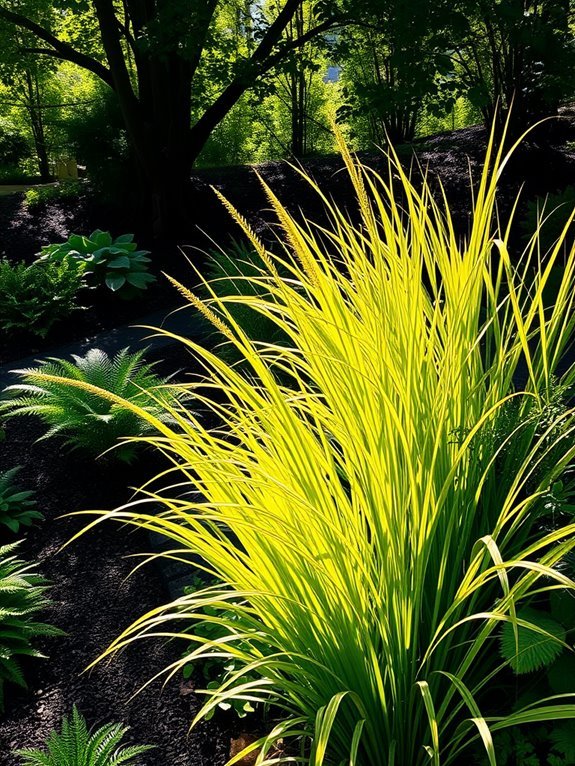
Imagine stepping into a lush, green oasis where the gentle sway of grass adds a touch of magic to your shady spots—meet Japanese Forest Grass!
This stunning plant brings a soft, flowing elegance to your landscape, thriving in those tricky shaded areas.
Here’s why you’ll love it:
- Grows beautifully in clumps
- Offers vibrant golden-yellow hues in fall
- Drought-tolerant once established
- Attracts butterflies and other pollinators
- Requires minimal maintenance
With its graceful appearance and low upkeep, Japanese Forest Grass is the perfect addition to your front yard, giving you that enchanting look you crave!
Sweet Woodruff

After enjoying the graceful charm of Japanese Forest Grass, it’s time to introduce another delightful shade-loving plant: Sweet Woodruff!
This little gem thrives in shady spots, making it perfect for your front yard. Its star-shaped leaves create a lush carpet, while delicate white flowers pop up in spring, adding a touch of whimsy.
Plus, it’s not just pretty; Sweet Woodruff has a lovely scent, reminiscent of freshly m
Cardamine (Bittercress)
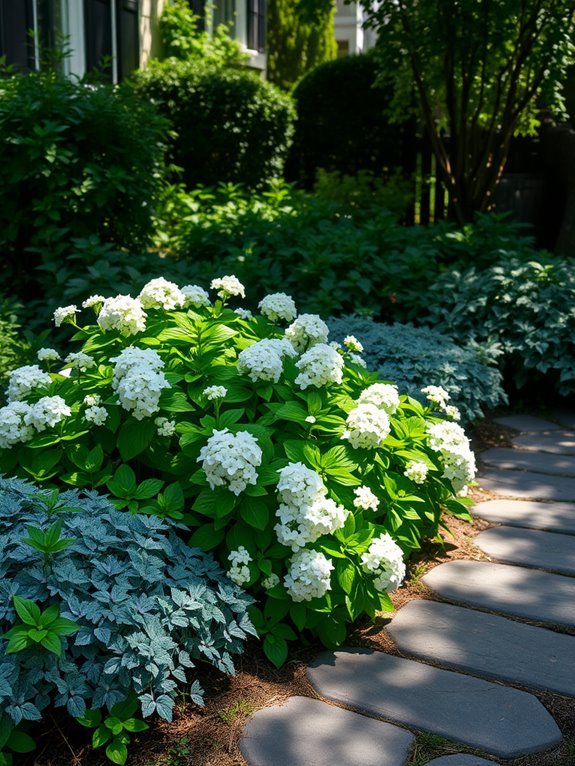
Meet Cardamine, commonly known as Bittercress, a charming little plant that’s perfect for adding a splash of greenery to your shaded spaces.
This delightful perennial thrives in moisture-rich soil and brings a vibrant touch to your garden. You’ll love its delicate white flowers and lush foliage, making it a favorite among shade lovers.
- Grows well in partial to full shade
- Attracts pollinators like bees and butterflies
- Offers a unique, feathery texture
- Tolerates a variety of soil types
- Can serve as a ground cover
Siberian Bugloss
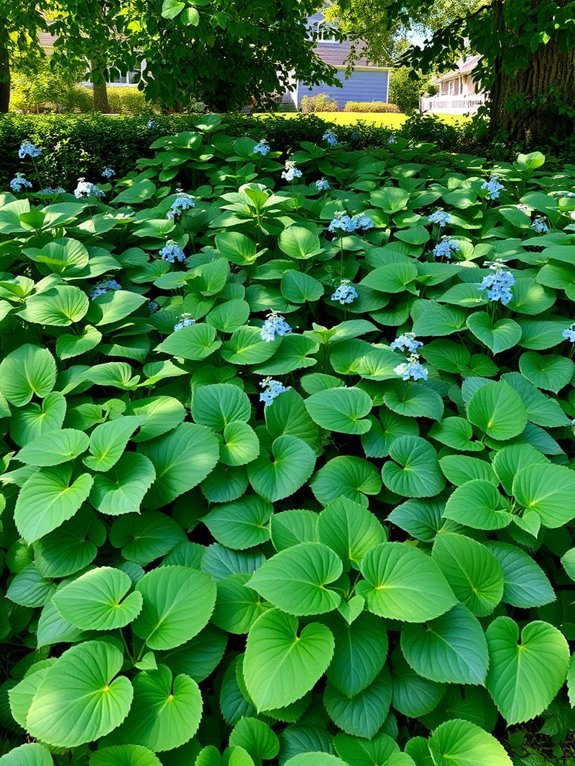
Siberian Bugloss, also known as Brunnera macrophylla, is a fantastic choice for those shady spots in your garden where you want to add a pop of color and texture.
With its striking heart-shaped leaves and vibrant blue flowers, it’s like nature’s confetti! These beauties thrive in moist, well-drained soil and can handle a bit of neglect, making them perfect for busy gardeners.
Plus, they’re deer-resistant, so you won’t have to share your garden goodies! Plant them in clusters for a stunning effect, and watch as they bring life to your shade garden while you sit back and enjoy the view.
Foxglove
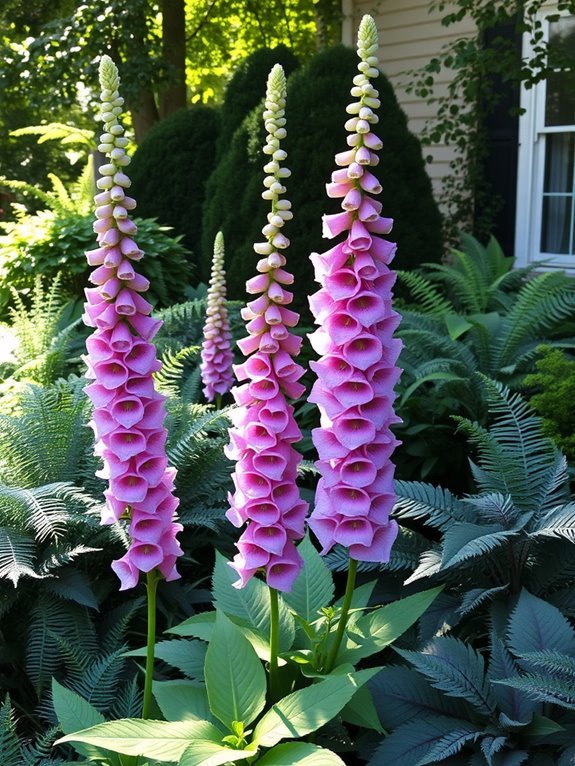
If you’re looking to add a touch of drama to your shade garden, Foxglove is your go-to! These stunning plants boast tall spikes adorned with bell-shaped flowers, creating a mesmerizing focal point.
They thrive in partial to full shade, making them perfect for those tricky spots. Plus, they’re low-maintenance and attract pollinators!
- Comes in various colors: pink, purple, white, and yellow
- Grows up to 5 feet tall
- Blooms in late spring to early summer
- Perfect for cottage gardens or woodland settings
- Beware! They’re toxic if ingested, so keep pets and kids in mind.
Japanese Iris
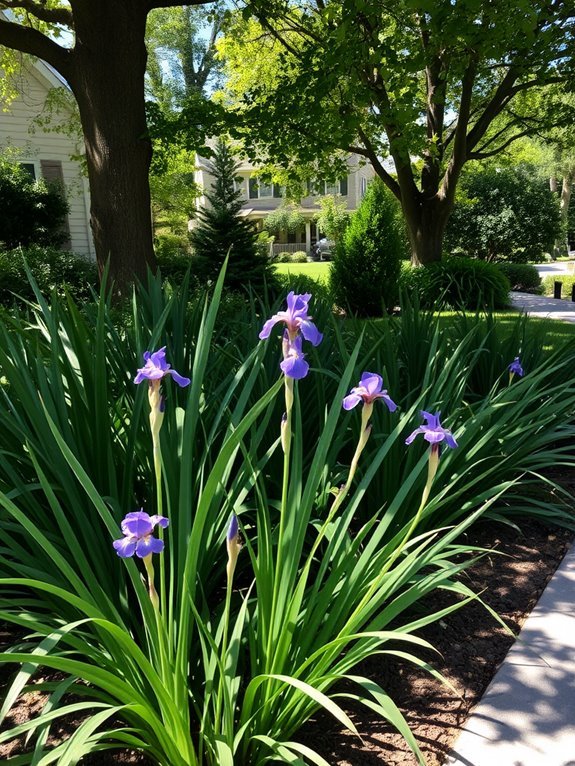
Japanese Iris brings a splash of elegance to any shade garden, with its striking blooms that seem to dance in the breeze.
These beauties thrive in moist, shady spots, making them perfect for your front yard. You’ll love how they brighten up those darker corners!
With their rich colors and graceful petals, they’ll have your neighbors saying, “Wow!” Care is simple too—just keep the soil damp, and they’ll reward you with vibrant flowers.
Plus, they attract butterflies, adding even more life to your garden.
Frequently Asked Questions
What Are the Best Soil Conditions for Shade Plants?
For shade plants, you’ll want well-draining soil that retains moisture without becoming waterlogged. A slightly acidic to neutral pH works best, so consider adding organic matter to enhance structure and nutrient content for ideal growth.
How Much Water Do Shade Plants Typically Need?
If you’re nurturing hostas, they typically need about an inch of water weekly. Keep the soil consistently moist but not soggy; you’ll encourage healthy growth and vibrant foliage by monitoring moisture levels closely.
Can Shade Plants Thrive in Dry Conditions?
Yes, some shade plants can thrive in dry conditions. You’ll need to choose drought-tolerant varieties and guarantee they’re well-established. Mulching helps retain moisture, so consider that too. Your garden can still flourish!
How Do I Prevent Pests on Shade Plants?
To prevent pests on your shade plants, regularly inspect them for signs of infestation, maintain healthy soil, and use natural repellents. Keep the area clean, and encourage beneficial insects to help control pest populations effectively.
When Is the Best Time to Plant Shade Plants?
The best time to plant shade plants is in early spring or fall. These seasons provide mild temperatures and adequate moisture, helping your plants establish strong roots before facing summer heat or winter cold.
Conclusion
With these 22 shade plants, your front yard can transform from “blah” to “ta-da!” in no time. Imagine your neighbors peeking over fences, curious about your landscaping skills.
It’s not just about aesthetics; you’re also creating a butterfly-friendly zone! Grab those plants and prepare for your garden—and your social life—to bloom!


